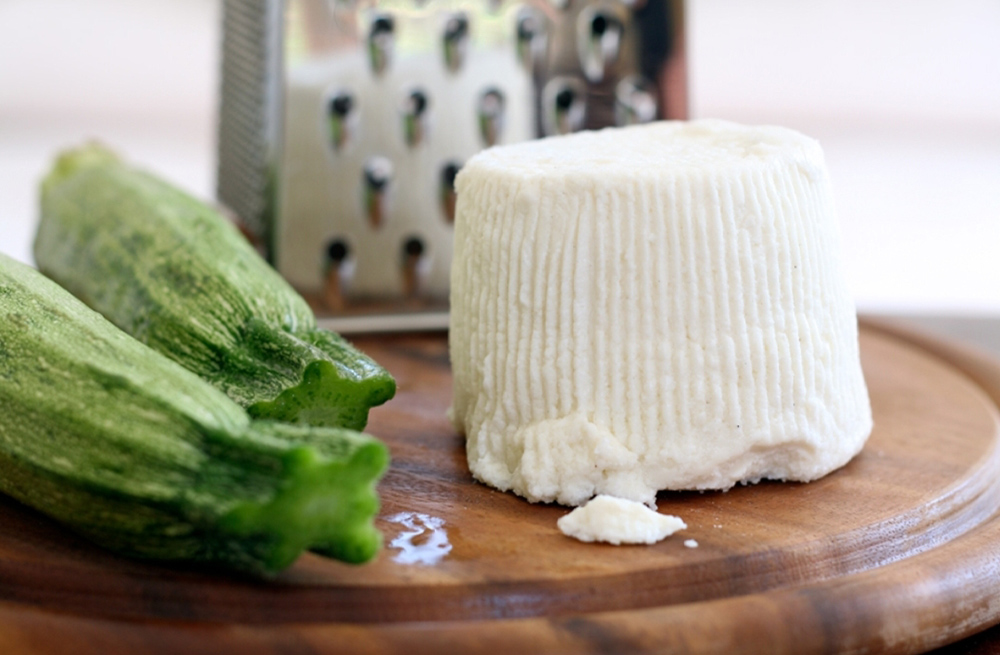A Tale of Two Cheeses
By Chef Joseph Massaglia

If I mention ricotta salata to you, do you immediately think of ricotta cheese? Although they share the same name and are somewhat related, they are very different cheeses. Ricotta cheese is an Italian whey cheese made primarily from sheep, cow, or goat milk whey. It’s a fresh cheese with creamy, fine textured curds that is commonly used in savory pasta dishes like lasagna and manicotti, and desserts like cheesecakes and, of course, cannoli. Ricotta, which means “recooked”, gets its name because it is made with the whey leftover from other cheese-making processes. It is similar to cottage cheese, but has smaller curds, and can be substituted in most recipes calling for cottage cheese.
According to Wikipedia, the production of ricotta in the Italian peninsula dates back to the Bronze Age. The ancient Romans made ricotta, but not much was mentioned about it by the writers of that time period. A likely reason is that ricotta was not profitable because it had a very short shelf life and was difficult to get to urban markets before it spoiled. It most likely was consumed by the shepherds who made it. Even so, evidence from paintings and literature indicates that ricotta was known and likely eaten by Roman aristocrats as well.
You can make your own ricotta at home; there are many, many recipes in cookbooks and on the internet. I’ve included one with this article that comes from a chef I trust – Ina Garten. I know her recipes work and if this is your first attempt at making ricotta, it should work well for you. This recipe is also available on the foodnetwork.com website.
Ricotta salata is primarily made from sheep’s whey, but salt (salata in Italian) is added after processing. The mixture is then put into molds (traditionally these molds were baskets) and aged for several months under pressure which causes the cheese to lose moisture and become dry, dense and somewhat crumbly. It has a snowy-white or ivory color and resembles an aged feta, but has a sharper taste. Some people say it has a strong, unique, acquired taste. It is sold in rounds with a basket-weave pattern on the outside, and is easily grated or crumbled. If you’re careful you can even slice it, but that can be difficult.

If you’ve never tried ricotta salata you should. It’s available in most grocery stores and really isn’t that expensive. It’s best used as a topping or garnish, or as an ingredient in salads or stirred into a side dish for an extra pop of saltiness.
Here are a few of my favorite ways to use ricotta salata:
Shave or grate it over fresh asparagus, or a salad made of fresh asparagus, fennel, mint and pea shoots.
Another salad idea is to toss it with arugula, apples or pears, cooked red beets and some hazelnuts or walnuts. Finish with a citrusy olive oil dressing.
Toss it with pasta made with lemon zest, olive oil, a little garlic, peas, asparagus and some grilled radicchio or endive for a taste of spring.
Or, cook your favorite pasta shape and stir in some garlic, spinach, chopped oil-cured black olives, chopped sun-dried tomatoes and crumbled ricotta salata.
Stir into an omelet or scrambled eggs with some parsley and other herbs of your liking.
It’s wonderful added to roasted small potatoes tossed with olive oil and additional fresh herbs to round out the flavor.
For a twist on traditional pizza, try a topping made from chopped oil-cured black olives and crumbled ricotta salata. You can do the same topping on bruschetta too – just combine the olives and cheese with some olive oil before putting on the bread.
And I like it crumbled on toasted Italian bread and drizzled with honey.
I hope you’ll give ricotta salata a try, and if you have some favorite recipes that call for feta, try substituting it in those recipes. I think you’ll be very happy.
Buon Appetito!
Ina Garten’s Homemade Ricotta
- Yield: About 2 cups
- 4 cups whole milk
- 2 cups heavy cream
- 1 teaspoon kosher salt
- 3 tablespoons good white wine vinegar
Set a large sieve over a deep bowl. Dampen 2 layers of cheesecloth with water and line the sieve with the cheesecloth.
Pour the milk and cream into a stainless-steel or enameled pot such as Le Creuset. Stir in the salt. Bring to a full boil over medium heat, stirring occasionally. Turn off the heat and stir in the vinegar. Allow the mixture to stand for 1 minute until it curdles. It will separate into thick parts (the curds) and milky parts (the whey).
Pour the mixture into the cheesecloth-lined sieve and allow it to drain into the bowl at room temperature for 20 to 25 minutes, occasionally discarding the liquid that collects in the bowl. The longer you let the mixture drain, the thicker the ricotta. (I tend to like mine on the thicker side, but some prefer it moister.) Transfer the ricotta to a bowl, discarding the cheesecloth and any remaining whey. Use immediately or cover with plastic wrap and refrigerate. The ricotta will keep refrigerated for 4 to 5 days.
c. 2010, Barefoot Contessa How Easy is That? All Rights Reserved
Joe’s Discount Club
* 10% off your wine purchase at Joe Canal’s Discount Liquor Stores, Egg Harbor Township, when you mention Joe’s Table for Two.
* Complimentary wine tasting at Bellview Winery when you mention Joe’s Table for Two.
* Reopening soon: Mama Mia’s in Marmora. www.mamamiasnj.com 609-624-9322





